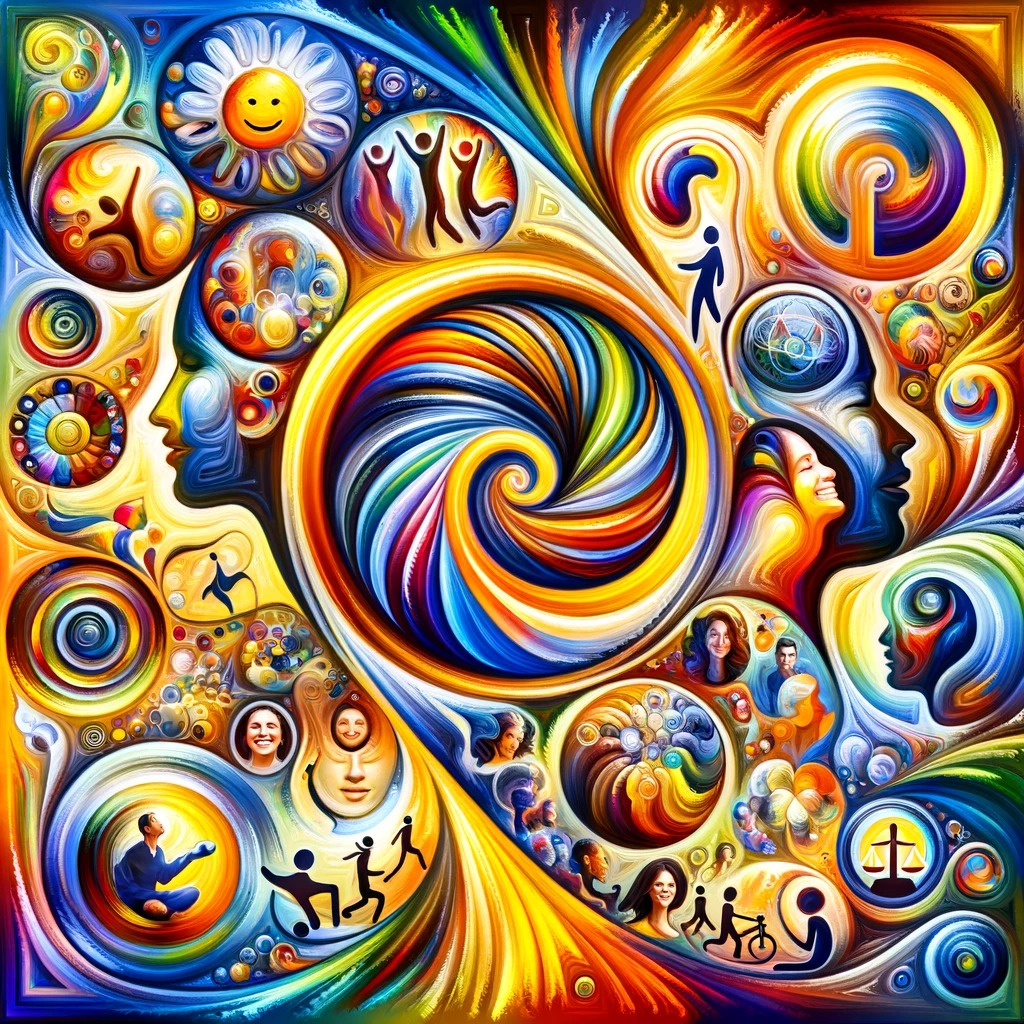“The purpose of our lives is to be happy.” – Dalai Lama
Happiness is a universal pursuit that transcends cultures, philosophies, and religions. While the definition and pathways to achieving happiness may vary across different societies, the underlying quest for a fulfilled and contented life remains constant.
Let’s explore the diverse perspectives on happiness as seen through the lenses of Eastern and Western philosophies. By examining the teachings of Buddhism, Hinduism, Confucianism, and Islam in the East, and comparing them with Aristotelian Ethics, Utilitarianism, Hedonism, and Positive Psychology in the West, we will be able to gain a comprehensive understanding of how different cultures approach the concept of happiness.
Eastern Perspective
In the Eastern perspective, happiness is often viewed as an inner state of peace and contentment, deeply rooted in spiritual and philosophical traditions. Below given are the FOUR concepts of Happiness from the Eastern perspective. Each of these concepts underscores the importance of inner transformation and alignment with higher principles for achieving lasting happiness
Buddhism: In Buddhism, happiness is achieved through a state of inner peace and contentment. This profound sense of well-being is cultivated through mindfulness and meditation, which help individuals become aware of their thoughts and emotions without attachment.
- Inner Peace and Contentment: Buddhism teaches that true happiness is achieved through a state of inner peace and contentment, which can be cultivated through mindfulness and meditation. Mindfulness practices help individuals become aware of their thoughts and emotions without attachment, leading to a reduction in suffering.
- Detachment from Desires: The concept of detachment from desires is central to Buddhist philosophy. Desires and attachments are seen as the root causes of suffering. By practicing detachment and developing a deeper understanding of the nature of reality, individuals can attain a state of nirvana, or ultimate happiness.
Hinduism: In Hinduism, happiness, known as ‘Ananda,’ is considered a state of spiritual bliss that transcends material pleasures. This profound joy is achieved through self-realization and union with the divine. The path to Ananda involves practices such as yoga, meditation, and devotion (bhakti), which help individuals connect with their inner self and the divine.
- Spiritual Bliss (Ananda): In Hinduism, true happiness, or ‘Ananda,’ is considered a state of spiritual bliss that transcends material pleasures. This state is attainable through self-realization and union with the divine.
- Self-Realization and Union with the Divine: The path to Ananda involves practices such as yoga, meditation, and devotion (bhakti). These practices help individuals connect with their inner self and the divine, leading to a deeper sense of fulfilment and joy.
Confucianism: In Confucianism, happiness is closely tied to social harmony, moral living, and fulfilling one’s roles within the community. Confucian teachings emphasize the importance of cultivating virtues such as filial piety, loyalty, and benevolence. Personal happiness is seen as deeply interconnected with the well-being of others and the society as a whole.
- Harmony in Relationships: Confucianism puts a lot of the importance on harmony in relationships and moral living as pathways to happiness. The teachings of Confucius highlight the significance of virtues such as filial piety, loyalty, and benevolence in achieving personal and societal well-being.
- Moral Living and Societal Order: A well-ordered society, where individuals adhere to ethical principles and respect hierarchical relationships, is seen as essential for achieving happiness. Confucius believed that personal happiness is deeply interconnected with the welfare of the community.
Islam: In Islam, happiness involves a balanced approach to life, combining worldly enjoyment with spiritual fulfilment. Islamic teachings emphasize the importance of worship, good deeds, and maintaining justice and compassion. A life of righteousness, faith, and adherence to Islamic principles leads to inner peace and contentment. The ultimate happiness is seen as achieving eternal bliss in the hereafter through a life devoted to Allah’s will, highlighting the significance of spiritual growth and moral integrity in attaining true happiness.
- Submission to Allah: In Islam, happiness (Sa’adah) is found through submission to Allah and living according to His guidance. This involves a balance between worldly enjoyment and spiritual fulfilment.
- Balance between Worldly and Spiritual Fulfilment: Islamic teachings emphasize the importance of worship, good deeds, and maintaining justice and compassion in one’s life. The ultimate happiness is achieving eternal bliss in the hereafter through a life of righteousness and faith.
Western Perspective
In the Western perspective, happiness is often associated with the pursuit of personal fulfillment, rational living, and the maximization of pleasure. Below given are the FOUR concepts of happiness from the Western perspective:
Aristotelian Ethics: In Aristotelian Ethics, happiness, or eudaimonia, is defined as living a virtuous life in accordance with reason. Aristotle posited that true happiness is achieved through the cultivation of moral virtues such as courage, temperance, and wisdom. This involves finding a balance between excess and deficiency, known as the “Golden Mean.” Happiness, in this context, is not just about experiencing pleasure but about fulfilling one’s potential and purpose through rational activity and ethical conduct. By living a life of virtue and reason, individuals can achieve a state of well-being and fulfillment that constitutes true happiness.
- Living a Virtuous Life: Aristotle held that eudaimonia is achieved through the cultivation of virtues such as courage, temperance, and wisdom.
- In Accordance with Reason: Aristotle believed that rational activity in accordance with virtue is the highest human good. This involves finding a balance between excess and deficiency, leading to a well-rounded and fulfilling life.
Utilitarianism: In Utilitarianism, happiness is defined as the greatest good, achieved by maximizing pleasure and minimizing pain for the greatest number of people. Proposed by philosophers Jeremy Bentham and John Stuart Mill, this ethical framework evaluates actions based on their outcomes, emphasizing the principle of utility. Happiness, in this context, is measured by the overall well-being and satisfaction generated by actions. The goal is to create the most happiness and least suffering, making ethical decisions that benefit the majority. Utilitarianism highlights the importance of considering the collective impact of actions to achieve the greatest overall happiness.
- Greatest Pleasure for the Greatest Number: Utilitarianism, proposed by philosophers like Jeremy Bentham and John Stuart Mill, suggests that happiness is the greatest good, measured by the greatest pleasure for the greatest number. This ethical framework evaluates actions based on their consequences, aiming to maximize overall happiness.
- Moral Calculations: Utilitarians use a form of cost-benefit analysis to determine the best course of action, considering the overall happiness or utility produced by different options.
Hedonism: In Hedonism, happiness is equated with the pursuit of pleasure and the avoidance of pain. This philosophical view posits that the most important goal in life is to maximize personal pleasure and minimize suffering. Hedonists believe that pleasure is the highest good and the primary driver of human actions. Happiness, therefore, is achieved through sensory and emotional experiences that bring joy and satisfaction, such as enjoying good food, engaging in enjoyable activities, and fostering loving relationships. Immediate gratification and indulgence in pleasurable activities are central to the hedonistic concept of happiness.
- Pursuit of Pleasure and Avoidance of Pain: As the hedonistic concept of happiness is based on the pursuit of pleasure and the avoidance of pain, hedonists argue that the most important goal in life is to maximize personal pleasure and minimize suffering.
- Sensory and Emotional Pleasures: This can involve sensory pleasures, such as enjoying good food and experiences, as well as emotional pleasures, like love and friendship. Hedonism emphasizes immediate gratification and the enjoyment of life’s pleasures.
Positive Psychology: Positive Psychology focuses on enhancing individual well-being through the cultivation of positive emotions, engagement, relationships, meaning, and accomplishments. This field of psychology, pioneered by Martin Seligman, seeks to understand and promote factors that allow individuals and communities to thrive. Happiness, in Positive Psychology, is achieved by fostering a fulfilling and balanced life. Practices such as gratitude journaling, developing strengths, building strong social connections, and finding purpose in life are emphasized. By focusing on what makes life worth living and nurturing positive experiences, Positive Psychology aims to help individuals achieve lasting happiness and overall well-being.
- Enhancing Individual Well-Being: Positive psychology focuses on enhancing individual well-being through positive emotions, engagement, relationships, meaning, and accomplishments.
- Building a Fulfilling Life: Researchers in positive psychology study what makes life worth living and how individuals can cultivate happiness. Interventions often include practices such as gratitude journaling, fostering positive relationships, and setting meaningful goals.
The exploration of happiness through Eastern and Western perspectives reveals a rich tapestry of philosophical and cultural approaches to understanding this complex emotional state. Eastern philosophies often emphasize inner peace, spiritual fulfilment, and social harmony, while Western philosophies highlight rational living, maximizing pleasure, and cultivating positive emotions. Despite these differences, the universal pursuit of happiness remains a testament to the shared human experience. By integrating insights from both traditions, individuals can adopt a more holistic approach to achieving a fulfilling and joyful life.
Hence, happiness is a multifaceted concept influenced by a combination of hormonal, neurological, and physiological factors. By understanding the roles of dopamine, serotonin, endorphins, and oxytocin, as well as the functions of various brain regions and the importance of physical health, sleep, exercise, and nutrition, we can better appreciate the complex mechanisms that underpin our emotional well-being. Integrating these insights into our daily lives can help us cultivate a more sustained and profound sense of happiness.
References
- Harvey, P. (2013). An Introduction to Buddhism: Teachings, History and Practices. Cambridge University Press.
- Prabhupada, A. C. B. S. (1986). Bhagavad-Gita As It Is. Bhaktivedanta Book Trust.
- Feuerstein, G. (2008). The Yoga Tradition: Its History, Literature, Philosophy, and Practice. Hohm Press.
- Yao, X. (2000). An Introduction to Confucianism. Cambridge University Press.
- Hall, D. L., & Ames, R. T. (1987). Thinking Through Confucius. SUNY Press.
- Nasr, S. H. (2002). The Heart of Islam: Enduring Values for Humanity. HarperCollins.
- Esposito, J. L. (2010). Islam: The Straight Path. Oxford University Press.
- Aristotle. (2004). Nicomachean Ethics (F. H. Peters, Trans.). Kessinger Publishing.
- Annas, J. (1993). The Morality of Happiness. Oxford University Press.
- Mill, J. S. (2001). Utilitarianism. Hackett Publishing.
- Bentham, J. (2007). An Introduction to the Principles of Morals and Legislation. Dover Publications.
- Epicurus. (1994). The Epicurus Reader: Selected Writings and Testimonia. Hackett Publishing.
- Feldman, F. (2004). Pleasure and the Good Life: Concerning the Nature, Varieties, and Plausibility of Hedonism. Oxford University Press.
- Seligman, M. E. P. (2011). Flourish: A Visionary New Understanding of Happiness and Well-being. Free Press.
- Lyubomirsky, S. (2007). The How of Happiness: A New Approach to Getting the Life You Want. Penguin Press.



